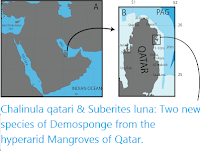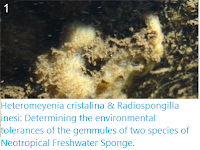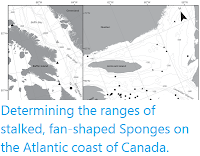Demosponges are the most abundant class of Poriferans in modern waters, with 72% of living Sponge species being Demosponges. They are characterised by a soft body covering a skeleton made up of spicules of calcite or aragonite. Members of the subclass Heteroscleromorpha also have silica spicules, but these are morphologically distinct from those of Glass Sponges, taking the form of monaxons (needle shaped spicules) and/or tetraxons (four-pointed spicules), as well as microscleres (small skeletal elements which are often highly distinctive at species level). The order Haplosclerida consists of Heteroscleromorph Sponges with skeletons comprised largely of oxeas monaxons pointed at both ends) and strongyles (monaxons with blunt ends), plus distinctive microscleres. The family Chalinidae are common marine encrusting Haplosclerid Sponges, found in protected environments as undersides of rocks and crevices, both in intertidal and subtidal habitats. The largest genus in the family Chalinidae is Haliclona, which contains over 350 species, and has been divided into numerous subgenera. Haliclona (Flagellia) is a recently erected subgenus characterized by the presence of flagellosigma microscleres (small, horseshoe-shaped spicules), which are often distinctive between species. Members of the taxon also have normal sigmas within a confused skeleton formed by oxea megascleres. The subgenus has a global distribution and contains 10 species.
In a paper published in the journal Zootaxa on 14 May 2020, Curtis Dinn of the Gulf Fisheries Centre of Fisheries and Oceans Canada, describes a large and abundant new species of Haliclona (Flagellia) collected throughout the southern Gulf of St. Lawrence, Canada.
The new species is named Haliclona (Flagellia) xenomorpha, where 'xenomorpha' means 'Alien-shaped' in reference to the thick and often irregular flagellosigmas. These spicules also resemble the derelict spacecraft from the 1979 film Alien directed by Ridley Scott, and the name pays homage to the titular antagonist of the series. This species is massively encrusting with raised oscula (large openings to the outside through which the current of water
exits after passing through the spongocoel, having been absorbed through
much smaller dermal pores). The Sponge is very friable and is thus often broken into pieces upon collection. The largest specimens are over 10 cm in diameter, but no consistent growth form is apparent. Larger specimens are often seen fully encrusting small pebbles and may have shell fragments incorporated into the tissue. The surface is generally smooth in more intact specimens, while fragments are more irregular and porous. In less damaged specimens, a fine transparent mesh covers the surface, but this often collapses after collection. Oscula are less than 0.5 cm wide and are raised above the surrounding tissue. Below the surface, the Sponge tissue is irregularly punctate. The consistency of large pieces is firm, compressible, but very brittle if pressure is applied, resulting in small crumbled pieces. The colour is pale yellow to light brown, with some specimens appearing pinkish.
Haliclona (Flagellia) xenomorpha. (A). Holotype ARC 81426. (B) Paratype ARC 81428 showing portions of smooth surface. (C) Specimen with smooth surface along an inner portion. (D) Large multispecies catch with Haliclona (Flagellia) xenomorpha (white arrows) and Mycale lingua (black arrows). (E), (F) Skeleton. Dinn (2020).
The skeleton of Haliclona (Flagellia) xenomorpha is confused, with a loose reticulation of paucispicular tracts which are irregularly connected by single spicules. Thick and thin oxeas do not appear to be localized in the skeleton. There is no surface specialization of spicules, but a layer of thick spongin is present at the surface in undamaged specimens. Flagellosigmas and sigmas are found throughout the choanosome, with regular sigmas often occurring in groups, especially evident near canal openings.
Megascleres (large spicules) are oxeas in two size categories. Thick oxeas are often slightly bent and have sharp tapered points, 250-298 × 12-17 μm. Thin oxeas are similarly shaped but with sharper ends which taper further along the shaft, 183-245 × 3.6-9.0 μm. Microscleres are flagellosigmas in two size categories and abundant normal sigmas. The distinctive thick category of flagellosigmas consists of spicules with curved ends that may be steeply curved, branched into two or more points, or not curved at all with endings pointing outwards, length of long endings 56-108 μm, of short endings 46-73 μm, width 58-98 μm, thickness 6.5-13 μm. Normal flagellosigmas are ovoid with widely curved ends, but are variable in size and overall shape, length of long endings 32-95 μm, of short endings 26-56 μm, width 40-77 μm, thickness 2.7-5.6 μm. Regular sigmas are variable in size, and have incurved apices, 39-82 μm in length and 3.2-7.1 μm thick. In some specimens thick flagellosigmas may appear more sigma-like with ends of similar lengths and a crescent shape, but these spicules may also have irregular ends.
Haliclona (Flagellia) xenomorpha, spicules. (A)–(B). Oxeas. (C)–(F) Thick flagellosigmas showing various degrees of irregularity. (G)–(H) Regular flagellosigmas. (I)–(J) Regular sigmas. Dinn (2020).
Several specimens of Haliclona (Flagellia) xenomorpha were collected along the American Bank near the Gaspé Peninsula and southern fringe of the Laurentian Channel. The holotype (when describing a new species
one specimen is designated the holotype; all future specimens
determined to belong to the same species as this holotype therefore
bellong to the species) was collected north of Brion Island, in the Magdalen Island Archipelago, near the shelf edge and was encrusting a rock. The species was collected at depths ranging from 41–89 m. Multiple specimens were collected in single trawls, but only single individuals from trawls were retained for taxonomic analysis.
The unique features of Haliclona (Flagellia) xenomorpha are the presence of thick flagellosigmas and two categories of oxeas. The thickness of the flagellosigma spicules exceed, and in most cases more than double the maximum thickness of spicules from other members of the genus. The flagellosigmas in Haliclona (Flagellia) xenomorpha reach a maximum thickness 13 μm, while flagellosigmas of Haliclona (Flagellia) porosa (also present in the Gulf of St. Lawrence) reach a maximum thickness of 6.3 μm. Thick flagellosigmas are common in the skeleton, and are thus considered as a second size category, though there may be intermediately sized flagellosigmas which are difficult to place in either size category. The consistently irregular endings of the thick flagellosigmas are also a defining character of the species.
See also...
Follow
Sciency Thoughts on Facebook.








